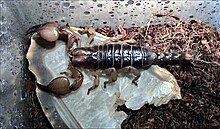Opistophthalmus

|
|
| Opistophthalmus | |
|---|---|
| Tricolored ryjący skorpion, O. glabifrons | |
| Klasyfikacja naukowa | |
| Królestwo: | Animalia |
| Gromada: | stawonogi |
| podtyp: | Chelicerata |
| Klasa: | pajęczaki |
| Zamówienie: | Skorpiony |
| Rodzina: | Skorpionowate |
| Podrodzina: | Scorpioninae |
| Rodzaj: |
Opistophthalmus Kocha , 1837 |
Opistophthalmus to rodzaj skorpionów znanych powszechnie jako skorpiony ryjące , skorpiony trójkolorowe , serkety lub skorpiony syczące . Występują głównie w południowej Afryce . Są znani z robienia głębokich i skomplikowanych nor.
Opis
Opistophthalmus są zazwyczaj silnie zbudowane jak na skorpiony i mają szerokie, potężne pazury ( chelae ). Różnią się kolorem od żółtego przez brązowy do czarnego , zwykle z ciemniejszymi lub jaśniejszymi obszarami. Kolor nóg jest zwykle znacznie jaśniejszy niż reszta ciała.
Gatunek
Źródła nie zgadzają się co do liczby gatunków należących do rodzaju, ale jest ich około 60:
- Opistophthalmus adustus (Kraepelin, 2898)
- Opistophthalmus ammopus (Lamoral, 1980)
- Opistophthalmus ater (Purcell, 1898)
- Opistophthalmus austerus (Karsch, 1879)
- Opistophthalmus boehmi (Kraepelin, 1896)
- Opistophthalmus brevicauda (Lawrence, 1928)
- Opistophthalmus capensis ( Herbst , 1800)
- Opistophthalmus carinatus ( Peters , 1861)
- Opistophthalmus cavimanus (Lawrence, 1928)
- Opistophthalmus chaperi (Simon, 1880)
- Opistophthalmus chrysites (Lawrence, 1967)
- Opistophthalmus coetzeei (Lamoral, 1979)
- Opistophthalmus concinnus (Newlands, 1972)
- Opistophthalmus crassimanus ( Purcell , 1899)
- Opistophthalmus fitzsimonsi (Hewitt, 1935)
- Opistophthalmus flavescens (Purcell, 1898)
- Opistophthalmus fossor (Purcell, 1898)
- Opistophthalmus fuscipes (Purcell, 1899)
- Opistophthalmus gibbericauda (Lamoral, 1979)
- Opistophthalmus gigas (Purcell, 1898)
- Opistophthalmus glabrifrons ( Peters , 1861)
- Opistophthalmus granicauda (Purcell, 1898)
- Opistophthalmus granifrons (Pocock, 1896)
- Opistophthalmus haackei (Lawrence, 1966)
- Opistophthalmus holmi (Lawrence, 1969)
- Opistophthalmus intercedens (Kraepelin, 1908)
- Opistophthalmus intermedius (Kraepelin, 1894)
- Opistophthalmus jenseni (Lamoral, 1972)
- Opistophthalmus karrooensis (Purcell, 1898)
- Opistophthalmus keilandsi (Hewitt, 1914)
- Opistophthalmus lamorali (Prendini, 2000)
- Opistophthalmus laticauda (Purcell, 1898)
- Opistophthalmus latimanus ( Koch , 1841)
- Opistophthalmus latro ( Torell , 1894)
- Opistophthalmus lawrencei (Newlands, 1969)
- Opistophthalmus leipoldti (Purcell, 1898)
- Opistophthalmus litoralis (Lawrence, 1955)
- Opistophthalmus longicauda (Purcell, 1899)
- Opistophthalmus lornae (Lamoral, 1979)
- Opistophthalmus luciranus (Lawrence, 1959)
- Opistophthalmus lundensis (Monrad, 1937)
- Opistophthalmus macer (Thorell, 1876)
- Opistophthalmus nitidiceps (Pocock, 1896)
- Opistophthalmus opinatus (Simon, 1888)
- Opistophthalmus pallipes (Koch, 1842)
- Opistophthalmus pattisoni (Purcell, 1899)
- Opistophthalmus penrithorum (Lamoral, 1979)
- Opistophthalmus peringueyi (Purcell, 1898)
- Opistophthalmus pictus (Kraepelin, 1894)
- Opistophthalmus pluridens (Hewitt, 1918)
- Opistophthalmus praedo (Thorell, 1876)
- Opistophthalmus pugnax (Thorell, 1876)
- Opistophthalmus pygmaeus (Lamoral, 1979)
- Opistophthalmus scabrifrons (Hewitt, 1913)
- Opistophthalmus schlechteri (Purcell, 1898)
- Opistophthalmus schultzei (Kraepelin, 1908)
- Opistophthalmus setifrons (Lawrence, 1961)
- Opistophthalmus ugabensis (Hewitt, 1934)
- Opistophthalmus wahlbergii (Thorell, 1876)
- Opistophthalmus werneri (Lamoral i Reynders, 1975)
W niewoli
O. glabrifrons , O. wahlbergii i O. boehmi są łatwo dostępne w handlu egzotycznymi zwierzętami domowymi . Są na ogół wytrzymałymi jeńcami, ale mają zwykle nerwowe usposobienie i jeśli są odpowiednio ustawione z głębokim podłożem, są rzadko spotykane, ponieważ przez większość czasu kopią i chowają się.
Toksyczność
W południowej Afryce powszechnie uważa się, że skorpiony o grubych pazurach należące do rodzin Scorpionidae, Bothriuridae i Ischnuridae są nieszkodliwe. Jednak Opistophthalmus glabrifrons jest wyjątkiem od reguły. Gatunki Opistophthalmus to skorpiony kopiące nory i prawdopodobnie nigdy nie opuszczają swoich nor, z wyjątkiem sytuacji, gdy wychodzą na gody. To prawdopodobnie odpowiada za czas i względną rzadkość ich użądleń.
